haddonstuff - where underachievement is a badge of honour |
||||||
| Home | BigList | About | Contact | Pugh | Pugh | McGrew |
Level
Crossings |
Stuff
stuffed in this section Level crossing types - industry definitions Major incidents - key UK level crossing incidents Click on the stuff subject and watch it appear below as if by magic |
In the United Kingdom, the term level crossing (LC) describes an intersection at the same elevation of a road, footpath or bridleway and one or more rail tracks. There are over sevcen and a half thousand crossings, ranging from full road width barriers to footpath crossings. The Rail Safety and Standards Board (RSSB) classify LCs as either active or passive, depending on whether warning is given of a train's approach. The Health and Safety Executive's Railway Principles and Guidance amplifies these classifications with conditions for suitability. Both approaches are adopted here.
ACTIVE CROSSINGS
These crossings give warning of a train's approach to vehicle users and pedestrians.
Manual crossings Manually controlled gate (MCG) These gated crossings are normally open to road traffic. A signaller or crossing keeper manually closes the gates across the full width of the road before a signal can be set to allow a train to pass over the crossing (the 'protecting signal'). Usually found where rail and road traffic is low. Manually controlled barriers (MCB) As above, full road width barriers are closed by a signaller or crossing keeper before the protecting signal can be cleared. There are usually road traffic signals (lights) and an audible warning. These crossings may also be operated remotely by a signaller who monitors the crossing using CCTV.
Automatic crossings Automatic Half-Barrier (AHB) These barriers are operated automatically by an approaching train (the train passes over a treadle at the 'strike-in point' some distance before the crossing which triggers the warning and closure sequence). These crossings have barriers that only cover the nearside of the road; this ensures the crossing exit is clear if the closing sequence starts when a vehicle is on the crossing. Road traffic signals and audible warnings are used. Telephones are provided to call the signaller in case of emergency. An AHB crossing is only installed where the maximum train speed is no greater than 100mph. Trains should arrive at the crossing in not less than 27 seconds after the amber lights of the road traffic signals first show. Automatic Barrier Crossing Locally Monitored (ABCL) To the road user these seem identical to the AHB. The key difference is that train drivers must ensure the crossing is clear before passing over it (see AOCL below). As a consequence, maximun train speed over a ABCL is 55mph. Automatic Open Crossing Locally Monitored (AOCL) These crossings have road traffic signals and audible warnings but no barriers. The warning sequence is (usually) automatic, as described above for AHBs. Train drivers are responsible for ensuring that the crossing is clear before passing over it. They look for a white flashing light signal which indicates that the crossing is working correctly. As with ABCLs, this limits the maximum train crossing speed to 55mph. Automatic Open Crossing Remotely Monitored As AOCL except the train driver does not monitor the crossing. Only one of these crossings is still in use on Network Rail - Rosane in Scotland. Conversions to AOCL or ABCL took place following recommendations in the Stott report after the multiple fatality at Lockington crossing in 1986. User Worked Crossing protected by Minature Warning Lights (UWC-MWL) Protected by gates or full barriers, the user has to operate these before crossing. Red and green warning lights, automatically operating by approaching trains, let users know if it is safe to cross. Lights are installed where the warning time of a train approach is less than the user's crossing time.
PASSIVE CROSSINGS
These crossings have no warning system to indicate a train's approach. The road user or pedestrian is repsonsible for ensuring that they can cross safely. User Worked Crossings (UWC) These crossings are found where private roads cross the railway, for example access to housing, industry or fields. Gates (or sometimes barriers) have to be operated by the user. It is the user's responsibility to ensure that it is safe to cross. User Worked Crossing with Telephone (UWC-T) As with UWCs above only a telephone is provided. The user must contact the signaller for permission to cross with vehicles or animals. Such crossings are suitable in locations where visibility of oncoming trains is limited. Open Crossings (OC) These are crossings with no gates or barriers and no warning of approaching trains, Road users and pedestrians must give way to trains. Such crossings have a maximum train crossing speed of 10mph. In some instances, the train must stop before the crossing to check that it is clear before proceeding. There should be only one one rail line over the crossing. Footpath crossings (FC) Pedestrian crossings with stiles or wicker gates to restrict access. The pedestrian is responsible for making sure that it is safe to cross. Where visibility of oncoming trains is limited, train drivers may vbe instructed to sound the train's whistle to warn of their approach (a trackside board instructs the driver to do this). |
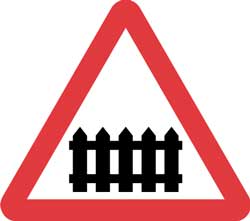 |
||
| Traffic sign for Level Crossing | |||
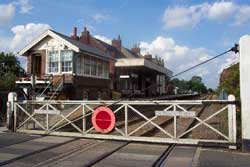 |
|||
| 1) Manually Controlled Gate | |||
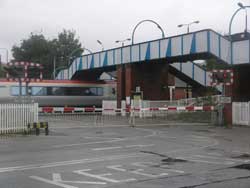 |
|||
| 2) Manually Controlled Barrier | |||
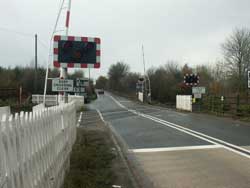 |
|||
| 3) Automatic Half Barrier | |||
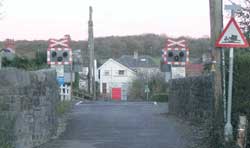 |
|||
| 4) Automatic Open Crossing | |||
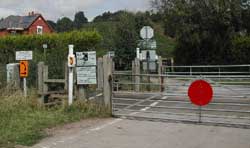 |
|||
| 5) User Worked Crossing with MWL | |||
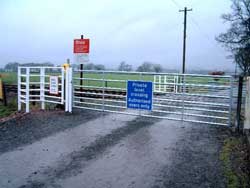 |
|||
| 6) User Worked Crossing with Telephone | |||
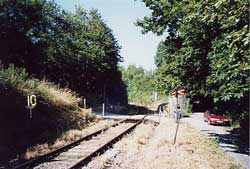 |
|||
| 7) Open Crossing | |||
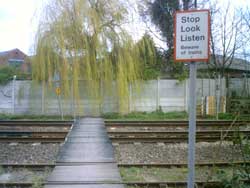 |
|||
| 8) Footpath Crossing | |||
Photographs: 2 and 8 - author's own collection Geograph is
a collaborative photography project aiming to obtain representative
photographs and information for every square kilometre of
the UK and Eire. |
|||
Copyright © haddonsnet 2005 |
|||